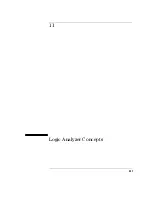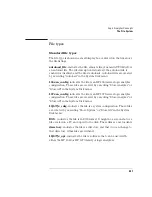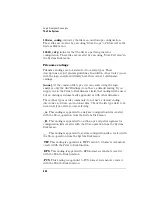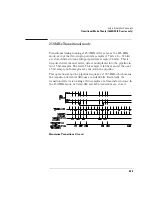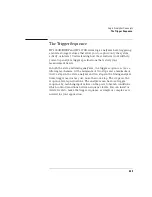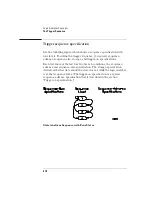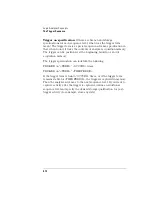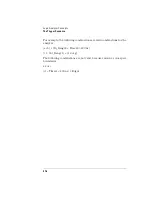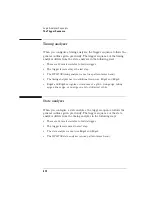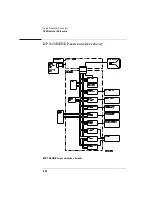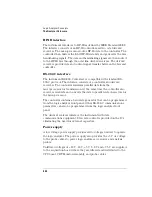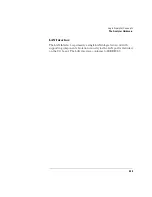
411
Logic Analyzer Concepts
The Trigger Sequence
Sequence-advance specification
The sequence-advance branch, sometimes called the "if" branch or
primary branch, always branches to the next level. You can specify the
following kinds of sequence-advance specifications:
Find (or Then find) "<TERM>" <OCCURS> time(S)
Find (or Then find) "<TERM>" <TIME PERIOD>
If the <TERM> is found <OCCURS> number of times or the <TERM>
remains stable for <TIME PERIOD>, the analyzer advances to the next
sequence level.
Sequence-else specification.
The sequence-else branch, sometimes
called the "else if" branch or secondary branch, may branch to any
other state, including the current state, a previous state, or a later
state. The sequence-else specification looks like the following:
Else on "<TERM>" go to level <sequence level>
If the Sequence-Else specification is satisfied before the sequence-
advance specification, the sequencer goes to <sequence level>.
The last state may only have a sequence-else branch specification,
which may branch to the same state or a prior state.
Storage specification.
In each state, a storage specification
determines the data stored by the analyzer while it is searching for the
sequence-advance, sequence-else, and trigger specifications. Storage
specifications are defined using the same pattern, range, and timer
resources available for defining branching specifications.
While storing "anystate", "no state", or "<TERM>"
Note that if you specify "no state," the analyzer still stores sequence-
advance terms and TRIGGER terms unless you also set Branches
Taken Not Stored in Acquisition Control in the Analyzer Trigger menu.
Summary of Contents for 1670E Series
Page 6: ...6 In This Book...
Page 26: ...26 Contents...
Page 27: ...27 Section 1 Logic Analyzer...
Page 28: ...28...
Page 29: ...29 1 Logic Analyzer Overview...
Page 39: ...39 2 Connecting Peripherals...
Page 49: ...49 3 Using the Logic Analyzer...
Page 72: ...72 Using the Logic Analyzer The Inverse Assembler...
Page 73: ...73 4 Using the Trigger Menu...
Page 101: ...101 5 Using the Oscilloscope...
Page 151: ...151 6 Using the Pattern Generator...
Page 199: ...199 7 Triggering Examples...
Page 237: ...237 8 File Management...
Page 249: ...249 9 Logic Analyzer Reference...
Page 360: ...360 Logic Analyzer Reference The Compare Menu...
Page 361: ...361 10 System Performance Analysis SPA Software...
Page 397: ...397 11 Logic Analyzer Concepts...
Page 430: ...430 Logic Analyzer Concepts The Analyzer Hardware Oscilloscope board theory Oscilloscope board...
Page 439: ...439 12 Troubleshooting the Logic Analyzer...
Page 455: ...455 13 Specifications...
Page 471: ...471 14 Operator s Service...
Page 479: ...479 Operator s Service Troubleshooting Troubleshooting Flowchart 2...
Page 491: ...491 Section 2 LAN...
Page 492: ...492...
Page 493: ...493 15 Introducing the LAN Interface...
Page 497: ...497 16 Connecting and Configuring the LAN...
Page 506: ...506 Connecting and Configuring the LAN Connecting and Configuring the LAN...
Page 507: ...507 17 Accessing the Logic Analyzer File System Using the LAN...
Page 515: ...515 18 Using the LAN s X Window Interface...
Page 527: ...527 19 Retrieving and Restoring Data Using the LAN...
Page 539: ...539 20 Programming the Logic Analyzer Using the LAN...
Page 546: ...546 Programming the Logic Analyzer Using the LAN Programming the Logic Analyzer Using the LAN...
Page 547: ...547 21 LAN Concepts...
Page 555: ...555 22 Troubleshooting the LAN Connection...
Page 580: ...580 Troubleshooting the LAN Connection Getting Service Support...
Page 581: ...581 Section 3 Symbol Utility...
Page 582: ...582...
Page 583: ...583 23 Symbol Utility Introduction...
Page 588: ...588 Symbol Utility Introduction Symbol Utility Introduction...
Page 589: ...589 24 Getting Started with the Symbol Utility...
Page 597: ...597 25 Using the Symbol Utility...
Page 609: ...609 26 Symbol Utility Features and Functions...

